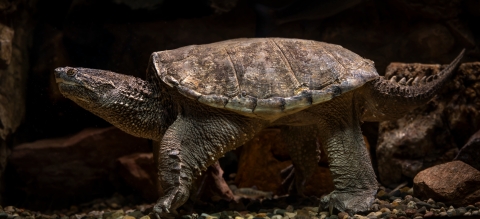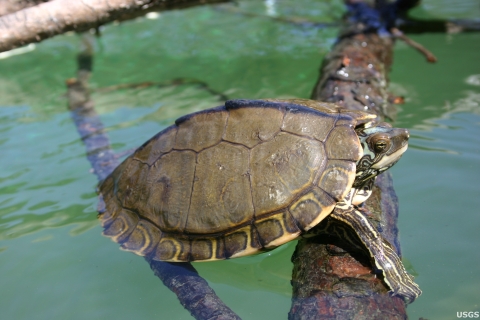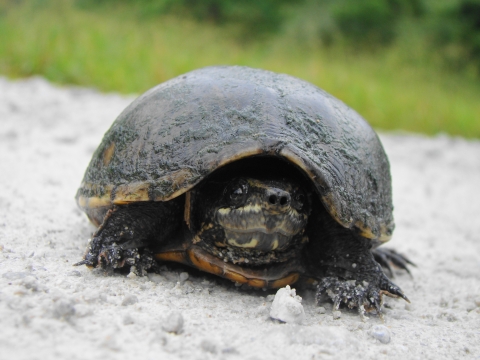Update: All turtle proposals submitted by the U.S. were adopted by the Parties, and the new inclusions to CITES Appendix II went into effect on February 23, 2023.
Some people think of alligator snapping turtles as the dinosaurs of the turtle world, in part because of their prehistoric appearance. The largest species of freshwater turtle in North America, alligator snapping turtles have massive heads with powerful hooked jaws used for snatching prey.
But these ancient reptiles also lived with dinosaurs — their fossils date back to the late Cretaceous Period, about 100 million years ago.
Unfortunately, these and other turtle species that have endured for millennia are experiencing drastic population declines today. On top of habitat loss, climate change climate change
Climate change includes both global warming driven by human-induced emissions of greenhouse gases and the resulting large-scale shifts in weather patterns. Though there have been previous periods of climatic change, since the mid-20th century humans have had an unprecedented impact on Earth's climate system and caused change on a global scale.
Learn more about climate change , and car strikes when crossing roads, turtles face growing threats from the wildlife trade.
Between 2013 and 2019, more than 200,000 alligator snapping turtles and more than 700,000 common snapping turtles were exported from the U.S., most destined for Southeast Asia and Europe for use as food or traditional medicine.
As of now, different states in the U.S. have different conservation- and trade-management strategies in place for turtle species that are sought after for human use. This inconsistent and fragmented approach makes it easy for people to exploit the trade, putting turtles at risk of extinction.
Biologically, turtles are more vulnerable to these losses than other wildlife because of their reproductive strategies. It takes turtles many years — often a decade or more — to reach reproductive age, if they make it at all. Most eggs and hatchlings don’t survive, falling victim to predators like foxes, skunks, and raccoons.
That means to replace itself in its population, a turtle must first survive long enough to reach maturity, and then must reproduce for its entire adult life — many decades — to ensure one or two eggs hatch and make it to adulthood as well.
Without checks on the number of turtles that are taken from the wild, we risk losing future generations, populations, and ultimately, entire species.
That’s why the United States is proposing amendments to the Convention on International Trade in Endangered Species of Wild Fauna and Flora (CITES) Appendices for 36 turtle species, including musk turtles, common and alligator snapping turtles, and softshell turtles. An Appendix-II listing for these species will help address illegal trade threats, support biologically sustainable use through legal trade, and complement domestic protections.
Here are snapshots of the species included in our proposals:
Alligator snapping turtle (Macrochelys temmincki)
Description
The largest species of freshwater turtle in North America is rarely seen on land. The alligator snapping turtle is highly aquatic and somewhat secretive. These ancient reptiles are primitive in appearance, characterized by a large head, long tail, and a powerful upper jaw with a strong hooked beak. Males can weigh more than 200 pounds, while females top out around 60 pounds.
Habitat
The alligator snapping turtle is found only in river systems in the U.S. that flow into the Gulf of Mexico, from the Suwanee River in Florida west to the San Antonio River in Texas. While the species occupies shallower waters in early summer, it is associated with the deeper waters where it spends its time in summer and winter months, including large rivers, major tributaries, bayous, canals, swamps, lakes, ponds, and oxbows. Alligator snapping turtles are also associated with submerged structures, like tree roots and stumps, and seek out canopy cover or undercut stream banks for shelter.
Threats
The primary threats to the alligator snapping turtle are bycatch associated with commercial fishing, habitat alteration, nest predation, and both the legal and illegal harvest — including for export. They are traded commercially in high numbers, with trade driven largely by demand for turtle meat in East Asia.
Common snapping turtle (Chelydra serpentina)
Description
While not as large as the alligator snapping turtle, the common snapping turtle is a relatively large turtle, characterized by a big head with a sharp hooked upper jaw, a long tail, and a rough, dark brown shell. These ancient reptiles generally take a decade or more to reach maturity and can live for 40 or more years.
Common snapping turtles and alligator snapping turtles can be distinguished by their size as adults, but juveniles of the species look similar and are the primary targets of the trade.
Habitat
Common snapping turtles are found throughout eastern North America, and inhabit all types of permanent aquatic habitats, including ponds, lakes, rivers, bogs, marshes, and occasionally brackish salt marshes. This species is highly aquatic and rarely seen basking on land.
Threats
Like the alligator snapping turtle the common snapping turtle is traded commercially in high numbers. They are primarily exported to provide turtle meat in East Asia, but people in the U.S. seek out snapping turtle meat for soups and stews as well.
Softshell turtles (Trionychidae spp. [three species])
Unlike most other turtles, softshell turtles have flat, leathery shells that are flexible, rather than hard and rigid. Some compare their appearance to a pancake. These aquatic turtles are well adapted for the water, with webbed feet, long necks, and tubular snouts that resemble a snorkel.
Habitat
The U.S. proposal focuses on three Trionychidae species in the genus Apalone native to the United States, Canada, and Mexico. Softshell turtles are found in rivers, streams, lakes, and reservoirs, and often bury themselves in the mud or sand where they sleep or wait for food to swim by.
Threats
Softshell turtles face threats from habitat loss and degradation, and from the legal and illegal trade for food and traditional medicine. While these species can be bred in captivity, they are easily caught and trapped in the wild, thereby making wild populations vulnerable to exploitation.
Broad-headed map turtles (Graptemys spp. [Five species])
Description
Map turtles are distinguished by the intricate faint yellow lines on their carapaces that resemble the lines on a topographical map. The name “broad-headed” refers to the enlarged heads that females in this genus develop as they age.
Habitat
These aquatic reptiles are found throughout North America, generally inhabiting small to large flowing rivers with abundant coarse woody debris for shelter and basking.
Threats
The five species of broad-headed map turtles are threatened by pollution in riverine habitats leading to the loss of their prey, habitat loss and alteration, and overharvesting for the international pet trade.
Musk turtles (Sternotherus spp. [Four species])
Description
The name of this turtle refers to the musky smell they secrete from two glandular openings on each side of their body near their carapace. These small aquatic turtles rarely leave the water, though some emerge to bask.
Habitat
Musk turtles are native to the freshwaters of North America, ranging from southeastern Canada to southeastern Florida. Their preferred habitat is slow-moving, permanent, freshwater with soft substrates for burrowing, and fallen trees, overhanging banks, and submerged logs and rocks for shelter and basking.
Threats
These turtles are threatened mainly by habitat loss and degradation but are also highly susceptible to collection for the pet trade. Live musk turtles are exported primarily to East Asia for commercial purposes.









